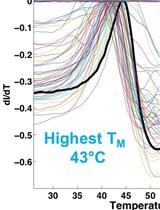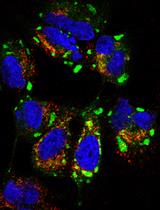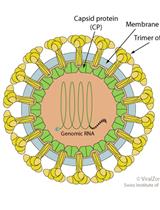- EN - English
- CN - 中文
Enzymatic Construction of Protein Polymer/Polyprotein Using OaAEP1 and TEV Protease
利用OaAEP1和TEV蛋白酶进行蛋白聚合物/多聚蛋白的酶促构建
发布: 2020年04月20日第10卷第8期 DOI: 10.21769/BioProtoc.3596 浏览次数: 4781
评审: Beatrice LiHongwei HanAnonymous reviewer(s)

相关实验方案

用热荧光法鉴定疱疹病毒蛋白UL37的最佳热稳定性和溶解度的缓冲液条件
Andrea L. Koenigsberg [...] Ekaterina E. Heldwein
2020年06月20日 3810 阅读
Abstract
The development of chemical and biological coupling technologies in recent years has made possible of protein polymers engineering. We have developed an enzymatic method for building polyproteins using a protein ligase OaAEP1 (asparagine endopeptidase 1) and protease TEV (tobacco etching virus). Using a mobile TEV protease site compatible with the OaAEP1 ligation, we achieved a stepwise polymerization of the protein on the surface. The produced polyprotein can be verified by protein unfolding scenario using atomic force microscopy-based single-molecule force spectroscopy (AFM-SMFS). Thus, this study provides an alternative method for polyprotein engineering and immobilization.
Keywords: Polymerization (聚合)Background
Several methods based on biochemical reactions for protein polymerization have been developed. For example, one approach is to design protein monomer with additional cysteines as the basic unit for ligation (Dietz et al., 2006; Durner et al., 2017). Another approach is to build the complete gene for the artificial protein oligomer (Carrion-Vazquez et al., 1999; Giganti et al., 2018). However, the engineering of large-sized protein polymer is often challenging. To address this challenge, we have developed an enzyme-mediated method that builds protein polymers/polyproteins in a stepwise fashion, using protein ligase and protease (Yang et al., 2017; Deng et al., 2019). When a TEV site (ENLYFQ/G) plus a leucine (L) is designed as ENLYFQ/GL-POI (POI: Protein of Interest) at the N-terminus of the protein unit, TEV cleavage produces an N-terminal GL residue of GL-POI, which is compatible with further OaAEP1 ligation. Our enzymatic method provides a new method for the preparation of the polyprotein sample with a controlled sequence and suitable for single-molecule studies, especially for complex protein systems.
The engineered polyprotein sequence is confirmed by individual protein unfolding event using AFM-SMFS. Besides a powerful imaging tool (Mannix et al., 2018), AFM can manipulate single molecule mechanically and directly measure its unfolding, unbinding, and rupture force (He et al., 2012; Scholl and Marszalek, 2018; Zhang et al., 2019). Thus, it is widely used to study protein (un)folding and mechanics (Infante et al., 2019; Krieg et al., 2019), protein-protein/ligand-receptor interaction (Ott et al., 2017; Zhang et al., 2019) and even chemical bond (Pill et al., 2019; Song et al., 2019; Yuan et al., 2019). Together with other established polyprotein engineering and immobilization methods (Dietz et al., 2006; Popa et al., 2013; Hoffmann et al., 2015; Walder et al., 2017), our enzymatic methodology can improve the quality and efficiency of SMFS study.
Materials and Reagents
- Glass coverslip (Sail Brand, China)
- E. coli BL21(DE3) (-80 °C)
- pQE80L-POI or pET28a-POI plasmid (Vector information in the Supplemetal file)
- Milli-Q water (18.2 MΩ/cm)
- Luria-Bertani (LB) medium (BD Difco)
- Iron (III) chloride hexahydrate (99%, Energy chemical)
- Calcium chloride hydrate crystalline aggregate (99.9965%, Alfa Aesar)
- (3-aminopropyl) triethoxysilane (APTES, 99%, Sigma-Aldrich)
- Sulfosuccinimidyl 4-(N-maleimidomethyl) cyclohexane-1-carboxylate (sulfo-SMCC, Thermo Scientific)
- Sodium chloride (NaCl) (99%, BBL Life Science)
- Tris(hydroxymethyl) aminomethane (Tris, > 99.9%, Sangon Biotech)
- EDTA (99.5%, Macklin)
- 5,5'-Dithiobis (2-nitrobenzoic Acid) (99%, Alfa Aesar)
- Ampicillin sodium salt (99% Zhu YanBIO)
- Kanamycin (≥ 750 μg/mg, Diamond)
- Magnesium sulfate (MgSO4) (AR, Shanghai Lingfeng Chemical Reagent Co., Ltd)
- Calcium chloride (CaCl2) (AR, Aladdin)
- D(+)-Glucose (AR, Aladdin)
- IPTG (Isopropyl-β-d-thiogalactopyranoside) (99% Zhu YanBIO)
- DNase (from Bovine Pancreas, Activity ≥ 500 Kunitz U/mg, Sangon Biotech)
- RNase (from Bovine Pancreas, Activity ≥ 60 U/mg, Sangon Biotech)
- PMSF (Zhu YanBIO)
- Potassium chromate (99.5%, Macklin)
- Concentrated sulfuric acid (AR, Sinopharm Chemical Reagent Co.,Ltd)
- Ethyl alcohol (AR, Sinopharm Chemical Reagent Co.,Ltd)
- Imidazole (99% Aladdin)
- Urea (AR, Sinopharm Chemical Reagent Co.,Ltd)
- TEV protease (produced by ourselves)
- OaAEP1 (produced by ourselves)
- BamHI (TaKaRa)
- BglII (TaKaRa)
- KpnI (TaKaRa)
- T4 Ligase (TaKaRa)
- Glycerol (99%, Macklin)
- M9 medium (see Recipes)
- Chromic acid (see Recipes)
- Lysis buffer (see Recipes)
- Wash buffer (see Recipes)
- Elution buffer (see Recipes)
- DTNB solution (see Recipes)
- TEV protease solution (see Recipes)
- AFM measurement buffer (see Recipes)
Equipment
- Avanti JXN-30 Centrifuge (Beckman Coulter)
- AKTA FPLC system (GE Healthcare)
- Mono Q 5/50 GL (GE Healthcare)
- NanoDrop 2000 spectrophotometer (Thermo Scientific)
- Nanowizard 4 AFM (JPK Instruments AG)
- Silicon nitride cantilever (MLCT, Bruker Corp)
- Sonictor (Biosafer 650-92)
Software
- JPK data processing (developed by JPK Instruments AG)
- Igor Pro 6.12 (Wavemetrics)
Procedure
文章信息
版权信息
© 2020 The Authors; exclusive licensee Bio-protocol LLC.
如何引用
Deng, Y., Shi, S., Zheng, B., Wu, T. and zheng, P. (2020). Enzymatic Construction of Protein Polymer/Polyprotein Using OaAEP1 and TEV Protease. Bio-protocol 10(8): e3596. DOI: 10.21769/BioProtoc.3596.
分类
生物化学 > 蛋白质 > 合成
分子生物学 > 蛋白质 > 检测
生物化学 > 蛋白质 > 荧光
您对这篇实验方法有问题吗?
在此处发布您的问题,我们将邀请本文作者来回答。同时,我们会将您的问题发布到Bio-protocol Exchange,以便寻求社区成员的帮助。
Share
Bluesky
X
Copy link











